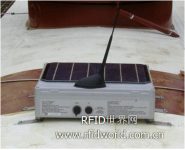
Dow Chemical uses RFID to monitor the transportation of hazardous chemicals in real time
[ad_1]
Dow Chemical Company uses an RFID system to monitor the status and position of the railcar carrying cylinders in real time. Railcars are used to transport inhaled hazardous substances (TIH). The system uses Salco Technologies’ EverSee2 transponder, including sensors, two-way satellite communication modem and GPS locator. The transponder sends information to Savi Technology’s SmartChain asset management platform and software, so that Dow Chemical regularly receives the latest position information of rail cars and alarm information of outstanding events. Dow can also share data with relevant government agencies.
Dow Chemical is currently constructing multiple product and container tracking projects. “About four years ago, the company formulated a strategy and planned to implement 50 different projects within 10 years,” said Craig Casto, Dow’s global leader in automatic identification and labeling technology. This includes the tracking of trucks, barges, rail cars, and various types of on-board containers. In 2005, Dow installed the Savi tracking system and related application software for TIH cylinders, and tracked TIH cylinders by applying barcodes and Savi 433 MHz active tags in the supply chain. Now, the company uses the new EverSee2 system on the Savi platform to help locate railcars loaded with hazardous chemicals. Dow has a total of 26,000 rail cars in North America, 650 of which carry TIH chemicals. Now, Dow is starting to install EverSee2 equipment on these 650 cars. At the end of this year, Casto said that all TIH rail cars will use the new tracking system.
At present, in order to comply with the requirements of the American Railroad Association, each freight rail car is equipped with two passive 915 MHz or 2.45 GHz RFID tags for vehicle positioning and tracking. Some railway stations are equipped with RFID readers, which can capture the ID numbers of passing vehicle tags and provide limited vehicle and cargo location data. “For most goods, this data is sufficient, but for dangerous products, Dow has been looking for a suitable real-time positioning system in the past,” Casto said.
In 2006, Dow and Chemical Dangerous Goods Transportation Emergency Advisory Center (Chemtrec) jointly developed the Dow Chemical Company’s railcar freight visibility project, testing the wireless tracking of railcars, and using a network-based platform that Dow and Chemtrec can share data. This project led to the application of the new rail car system.
The EverSee2 transmitter can be set to “wake up” in a certain period of time and send a “I am here” signal, which includes the latitude and longitude of the tag location and detailed sensor information, such as the temperature in the car. The data is sent to the Savi software via satellite so that Dow, Chemtrec and other authorized parties can obtain relevant information and receive emergency alerts.

The EverSee2 transmitter is installed on the top of the rail car and is connected to the sensor by wire to monitor the condition of the cylinder and its internal chemical substances
Salco used to supply rail car repair parts for loading and unloading dry and wet chemicals carried by rail cars. In recent years, Salco’s customers have asked Salco to provide a tracking solution for hazardous substances, said company chairman Dave Oestermeyer. In 2006, Salco received an inquiry from Dow for this type of tracking device, which prompted the development of the EverSee2 system. EverSee is 24 inches high, 14 inches long and 14 inches wide, including a GPS device and other devices installed on the surface of the rail car or Inside the vault of the vehicle, there is a sensor wired to EverSee2. The sensor is charged by a solar panel and a rechargeable battery, and includes an antenna for satellite launch. The sensor can provide relevant data of the item, such as whether there is leakage and the internal temperature of the cylinder.
When the EverSee2 device is installed on the rail car, the device can be set to send its ID number, location and sensor data. The information was sent to the nearest of 29 Orbcomm low-Earth orbit satellites. The Orbcomm satellite sends the data to Salco, which then sends it to the Savi software for compilation.
If Dow wants to send commands to the EverSee2 device (such as instructing the device to send its latest sensor status, or change the setting of information transmission), this function can be realized by Salco’s Fullview software through the Orbcomm satellite system. The user logs in to the Fullview software and selects the command sent to EverSee2 for a single device or a group of devices. The Salco firmware of EverSee2 allows EverSee2 to receive commands and react to them. Salco also designed a Bluetooth upgrade version of EverSee2, Oestermeyer said, allowing emergency personnel to use a laptop to send commands to the EverSee2 device on the rail car to download sensor data from a distance of up to 1,000 feet. If there is an emergency or the vehicle derails, emergency personnel can use this function when they need to judge the safety of the vehicle-mounted items.
This system was tested when Hurricane Ike came. Vehicles and equipment sent the latest item status information every hour. Heavy winds and heavy rain did not affect the operation of the system. The system fully realized the original intention of the design.
[ad_2]




